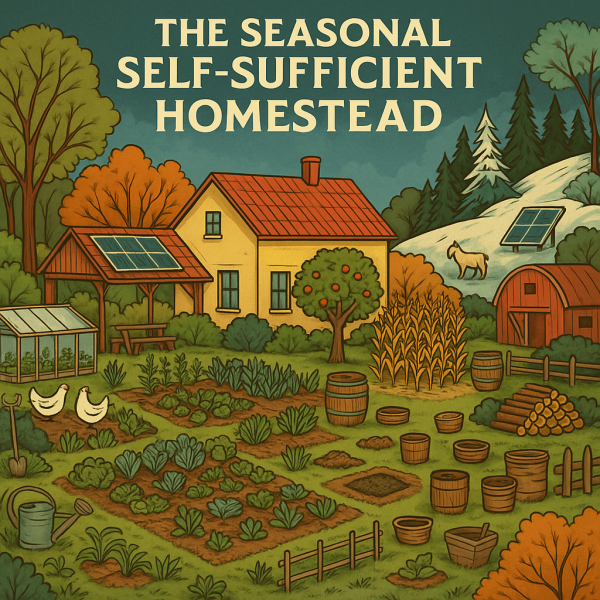🔄 Introduction: Why Seasons Matter on a Homestead
Most people live by a calendar. But the self-sufficient homesteader lives by the sun, the moon, and the soil. Understanding and adapting to the natural rhythm of the seasons is the secret to creating a resilient, abundant, and balanced homestead.
This isn’t about grinding harder—it’s about syncing with the seasons so each action builds toward year-round abundance. Whether you're growing food, storing it, raising animals, or managing energy and water—timing is everything.
In the realm of self-sufficient homesteading, success isn't dictated by the Gregorian calendar but by the rhythms of the sun, moon, and soil. By attuning to these natural cycles, homesteaders can cultivate resilience, abundance, and harmony throughout the year.

🌸 Spring: Planning, Planting, and Preparation
Spring is your reset button—what you prep now echoes through the year.
Key Focus Areas:
-
Garden Prep & Soil Revitalization: Conduct soil tests and amend beds with compost to enhance fertility.
- Seed Starting: Initiate indoor seed germination for early crops.
-
Tree Planting and Perennial Care: Establish new trees and maintain existing perennials.
-
Livestock Birthing and Brooding: Prepare for new animal arrivals.
-
Rainwater System Checks and Upgrades: Ensure water systems are ready. Inspect and/ or upgrade rainwater harvesting setups.
-
Tool Sharpening, Repair, and Inventory: Get tools in top shape. Repair any winter or storm damage and check your inventories.
Spring Project Ideas:
-
Build a cold frame or greenhouse for early planting.
-
Install drip irrigation systems.
-
Construct or repair animal shelters.
☀️ Summer: Growth, Maintenance, and Abundance
This is when things get wild. Your garden’s exploding, the bees are buzzing, and every day brings a new harvest.
Key Focus Areas:
-
Pest Control and Companion Planting: Implement companion planting and natural deterrents to manage pests naturally.
-
Daily Harvests and Crop Rotation: Keep up with abundant yields by engaging in daily harvests and beginning to preserving early crops.
-
Managing Heat Stress for Plants and Animals: Ensure livestock have adequate shade and hydration by providing shade and water.
-
Beginning Food Preservation: Start drying herbs and early crops.
Summer Project Ideas:
-
Build a solar dehydrator for preserving herbs and fruits.
-
Expand trellises to support climbing vertical crops.
-
Experiment with solar cooking methods.
🍂 Fall: Harvest, Preservation, and Planning
This is your bottling time—capture the energy of the year before winter settles in.
Key Focus Areas:
-
Full-Scale Food Preservation: Canning, freezing, drying, and root cellaring for winter storage.
-
Animal Culling and Meat Processing: Cull animals as needed and process meat for storage.
-
Seed Saving for Next Spring: Collect and store seeds from heirloom varieties & anything else you might want to grow again.
-
Soil Building: Add compost and mulch to beds to prepare for winter.
Fall Project Ideas:
-
Build or stock your root cellar for cold storage.
-
Install hoop houses to extend the growing season for fall/winter greens.
-
Render tallow and lard for cooking and soap-making.
❄️ Winter: Rest, Repair, and Reflection
This is your pause—but not your stop. Nature may sleep, but your homestead dreams bigger.
Key Focus Areas:
-
Equipment Maintenance and Tool Repair: Sharpen and repair tools for the upcoming season.
-
Plan Next Year’s Garden and Livestock Rotations: Strategize for the upcoming year, design next year's garden layout and crop rotations..
-
Education: Read, study, and learn new skills.
-
Indoor Growing: Cultivate microgreens, sprouts, and herbs indoors..
Winter Project Ideas:
-
Design your next permaculture zone to optimize land use.
-
Brew vinegar, kombucha, or mead for health and preservation.
-
Build a solar heater or improve insulation in structures.
